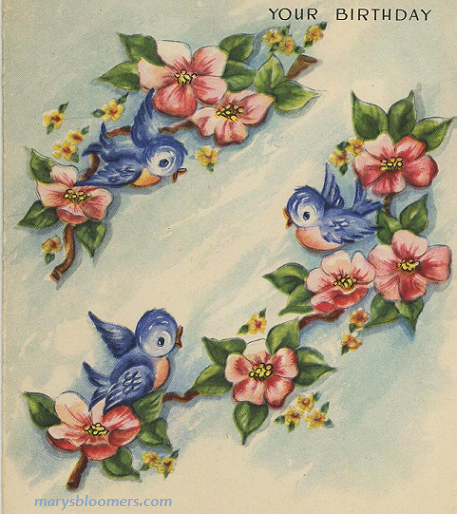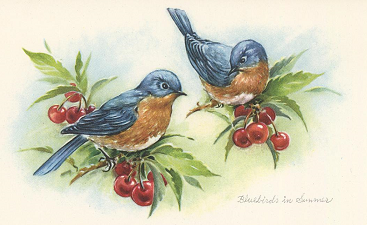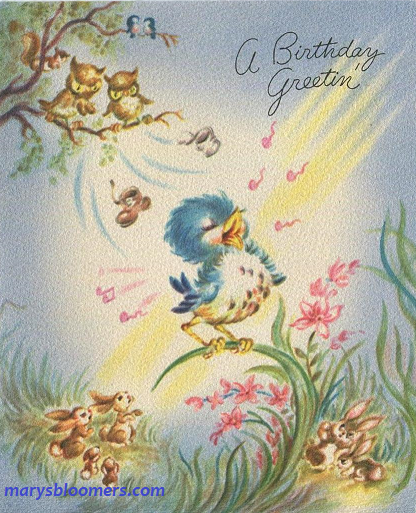 |
The Bluebird is symbolic of happiness, and is
artfully represented in many cultures. This symbolism may date back thousands of
years.
"There never was a happier or
more devoted husband than the male bluebird. He is the gay champion and
escort of the female at all times, and while she is sitting, he feeds
her regularly."
-John Burroughs
Among some Native Americans, the bluebird has mythological or
literary significance.
The Navajo identify the mountain bluebird as a spirit in animal form,
associated with the rising sun.
According to the Cochiti tribe, the firstborn son of Sun was named
"Bluebird". The most widespread species and best-known bluebird is the eastern bluebird. |
Eastern BluebirdRange: Eastern Bluebirds are year-round residents in the southern United States. They typically begin nesting as early as January in the south and in March in the northern United States and southern Canada. They are also found in parts of Mexico, Central America, and Bermuda. Field marks: Males are bright blue above and rusty orange below with a white belly. Females look similar but have a blue-gray back and lighter orange underparts. Both sexes are seven inches long and stout-billed. In flight, look for short blue wings and tail. Feeding: Eastern Bluebirds feed on
ground-dwelling insects, including beetles, crickets, grasshoppers, and
caterpillars, which they can spot while perched as far as 150 feet away.
They pounce upon their insect prey, then fly to a perch and strike it
against a hard surface before feeding—or they just catch and eat
insects in the air. Adults also feed juicy, high-protein spiders to
nestlings. Wild berries are also eaten, especially in colder months. At
feeders, offer raisins, currants, suet mixes, and mealworms (live or
freeze-dried). Western BluebirdRange: Western Bluebirds are found in southwestern Canada, Mexico, and many western U.S. states. They are medium- to short-distance migrants that winter in the southern part of their range and begin nesting in early April. Field Marks: Adult males have cobalt blue wings and tails as well as an all-blue head, chin, and throat, and a white belly. The upper breast is chestnut with varying pat-terns of blue and gray. The back may be partly or entirely chestnut. Females are a paler, grayer version of the male. Feeding:
Western Bluebirds eat insects
in warm weather, and fruits and berries in winter. Mistletoe and juniper
berries are favorites, and they love mealworms at feeders. They are
often seen “fly catching” or foraging on the ground, using low
branches as a jumping-off place.
Mountain BluebirdRange: Mountain Bluebirds are found primarily in the western mountains from east-central Alaska to south-central Mexico, migrating to the northern parts of their range to begin nesting in late April. Field Marks: Breeding males have a turquoise-blue back, a paler blue breast, and white belly and under tail coverts. Females and juveniles are gray above and have pale blue wings and tail and a buffy chest. The adults are slightly larger and thinner-billed than other bluebirds; their wings are proportionately longer than the other bluebird species. Feeding: Mountain Bluebirds feed on insects, including weevils, wasps, beetles, bees, grasshoppers, caterpillars, and crickets. They often “hover hunt” when foraging, or hunt from low perches before dropping or darting upward to capture prey. In late winter, they rely on native berries of mistletoe, hackberries, juniper, and hollies.
|
|
|
Is there any sign of spring quite so welcome as
the glint of the first bluebird unless it is his softly whistled song?
No wonder the bird has become the symbol for happiness. Before the
farmer begins to plough the wet earth, often while snow is still on the
ground, this hardy little minstrel is making himself very much at home
in our orchards and gardens while waiting for a mate to arrive from the
South. |
The love-making of the bluebird is as beautiful
as the bird itself, and normally as gentle, unless interrupted by some
jealous rival who would steal his bride; then gentleness gives place to
active combat. The male usually arrives a few days ahead of the female,
selects what he considers to be a suitable summer home, and carols his
sweetest, most seductive notes day after day until she appears in answer
to his call. |
| Be like the bluebird who never
is blue, For he knows from his upbringing what singing can do. -Cole Porter |
Blue skies Smiling at me |
|
If there is no response in you to the awakening
of nature -if the prospect of an early morning walk does not banish
sleep, if the warble of the first bluebird does not thrill you -know
that the morning and spring of your life are past. |
Late at night when the wind is still |
|
The bluebird carries the sky on his back. -Henry David Thoreau |
When nature made the blue-bird she wished to
propitiate both the sky and the earth, so she gave him the color of the
one on his back and the hue of the other on his breast |
| The soft mellow warble of the bluebird, heard at
its best throughout spring and early summer, is one of the sweetest,
most confiding and loving sounds in nature. - Thomas Roberts |
The bluebird is well named, for he wears a coat of the
purest, richest, and most gorgeous blue on back, wings, and tail; no
North American bird better deserves the name, for no other flashes
before our admiring eyes so much brilliant blue. |
|
Bluebird Artwork on Vintage Greeting Cards |
|
|
|
|
|
|
 |
 |
 |
|
-Vintage Greeting Card graphics downloads will be on this page *Adapted from information
provided by Audobon
|
|
Content, graphics and design ©2020 eyecandee.com
All rights reserved
This site uses Watermarkly Software


